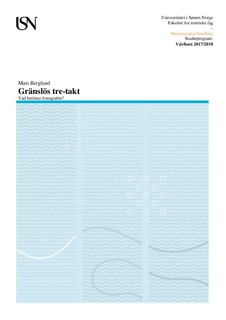| dc.description.abstract | This thesis is a systematic investigation and comparison of three fiddlers who were recorded on phonograph and were active tradition bearers in the borderland, both geographically, historically and culturally in the area connecting Hedmark, Dalarna and Värmland. The focus of my investigation is the asymmetric three-beat music rhythm these musicians used in this area. This rhythm topic creates, and will continue to create, lively discussions on how best to music notate it. Throughout my adult life I have worked as a musician, and as such I have studied music and dance in the Swedish-Norwegian borderlands. My empirical experiences have served as valuable tools complementing the more scientific study methods utilised. This thesis aims to highlight asymmetric three-beat rhythm and the connected problems that arise when discussing the same, in particular, on where the bar lines should best be placed. In my capacity as a musician, my experiences interacting with music and dance, have over time gained me an intuitive feel how I understand, or feel, this specific three-beat rhythm, and, how I, based on this understanding, place the bar lines in the music. To explain this “feeling”, which within musicological studies, is referred to as ‘implicit’ or “silent knowledge”, is one of the main challenges of this thesis. | nb_NO |
